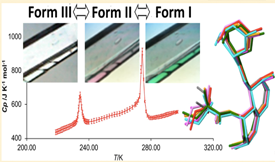
Polymorphism in Simvastatin: Twinning, Disorder, and Enantiotropic Phase Transitions
R.G. Simões, C.E.S. Bernardes, A. Joseph, M.F.M. Piedade, W. Kraus, F. Emmerling, H.P. Diogo, M.E. Minas da Piedade
Mol. Pharmaceutics 2018, 15, 5349-5360.
Abstract
Simvastatin is one of the most widely used active pharmaceutical ingredients for the treatment of hyperlipidemias. Because the compound is employed as a solid in drug formulations, particular attention should be given to the characterization of different polymorphs, their stability domains, and the nature of the phase transitions that relate them. In this work, the phase transitions delimiting the stability domains of three previously reported simvastatin forms were investigated from structural, energetics, and dynamical points of view based on single crystal X-ray diffraction (SCXRD), hot stage microscopy (HSM), and differential scanning calorimetry (DSC) experiments (conventional scans and heat capacity measurements), complemented with molecular dynamics (MD) simulations. Previous assignments of the crystal forms were confirmed by SCXRD: forms I and II were found to be orthorhombic (P212121, Z′/Z = 1/4) and form III was monoclinic (P21, Z′/Z = 2/4). The obtained results further indicated that (i) the transitions between different forms are observed at 235.9 ± 0.1 K (form III → form II) and at 275.2 ± 0.2 K (form II → form I) in DSC runs carried out at 10 K min−1 and close to these values when other types of techniques are used (e.g. HSM). (ii) They are enantiotropic (i.e., there is a transition temperature relating the two phases before fusion at which the stability order is reversed), fast, reversible, with very little hysteresis between heating and cooling modes, and occur under single crystal to single crystal conditions. (iii) A nucleation and growth mechanism seems to be followed since HSM experiments on single crystals evidenced the propagation of an interface, accompanied by a change of birefringence and crystal contraction or expansion (more subtle in the case of form III → form II), when the phase transitions are triggered. (iv) Consistent with the reversible and small hysteresis nature of the phase transitions, the SCXRD results indicated that the molecular packing is very similar in all forms and the main structural differences are associated with conformational changes of the "ester tail". (v) The MD simulations further suggested that the tail is essentially "frozen" in two conformations below the III → II transition temperature, becomes progressively less hindered throughout the stability domain of form II, and acquires a large conformational freedom above the II → I transition. Finally, the fact that these transitions were found to be fast and reversible suggests that polymorphism is unlikely to be a problem for pharmaceutical formulations employing crystalline simvastatin because, if present, the III and II forms will readily convert to form I at ambient temperature.
Return Previous Next